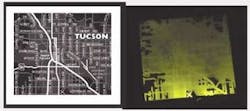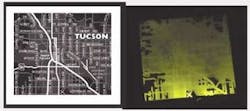Film printed on cloth emits light
Last spring, researchers at the Optical Sciences Center at the University of Arizona (Tuscon, AZ) succeeded in printing light-emitting nanofilms on cloth. As a result, Ghassan E. Jabbour, the leader of the multidisciplinary research team that is pioneering the effort, began to dream of a future full of homes with light-emitting draperies, soldiers consulting electroluminescent areas of their clothing for the latest dispatches from remote command posts, and libraries full of randomly accessible information on 1 x 1-in. chips.
"The films we are making and can make consist of organic or hybrid organic-inorganic materials that can transport charge, emit light, convert light to electrical power, or store data," he said. In addition to printing the usual decorative patterns and holiday designs, the group has also begun to print other items, such as this street map of Tucson printed on flexible plastic shown next to an actual map printed on paper. "For a first effort, it is extremely good," Jabbour said. "You can see the roads pretty nicely."
Part of the background is dim because the original map had a shadow in it, he noted. The light-emitting map can also be made to emit outside of the visible spectrum, such as in the infrared, for security applications. The ultimate goal of the research is to print nanofilms using traditional tools like screen, inkjet, laser, or gravure printing, he said.
Full realization of the potential capabilities of nanofilm printing on textiles awaits the successful negotiation of natural impediments such as moisture. While cloth and plastics can retain water and allow it to penetrate freely, circuitry printed on those materials will obviously require some sort of moisture-proof encapsulation to provide reasonable longevity for day-to-day applications. Other barriers include fine-tuning the images to achieve print quality comparable to what is currently available on paper. There are also materials issues to be addressed. "But the indications show it can be done," Jabbour said. "It will work eventually; it's just a matter of time and investment."

